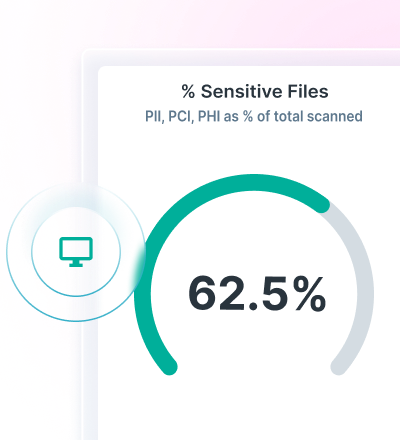5 Top Takeaways from the Gartner DSPM Market Guide
0 Minuten Lesezeit

Tim Herr
For organizations navigating a data landscape reshaped by generative AI, cloud expansion and compliance demands, Data Security Posture Management (DSPM) has become an essential foundation of their data protection.
DSPM helps identify sensitve data. The Gartner Market Guide for Data Security Posture Management provides timely insights to help readers evaluate the DSPM market and the vendors competing in the space.
To see how peers are approaching data visibility and control, explore how leading DSPM solutions are evolving to meet today’s challenges.
Below are several key takeaways from the Gartner report highlighting why, as we see it, DSPM is central to securing data in the era of AI.
1. DSPM Is now a core data security capability
Data security posture management (DSPM) solutions provide essential visibility into constantly moving and exposed data, especially as more data is used for AI purposes. It bridges the gap between data discovery/classification and the eventual implementation of automated remediation controls.
In our view, Gartner positions DSPM not as a niche capability but as a cornerstone of a modern data security program. It provides the clarity needed to answer fundamental questions such as where is your sensitive data, who can access it and whether it is at risk. DSPM connects insight to action by showing not just what data exists but whether it is being handled appropriately.
For example, it can reveal if a contractor has access to Social Security numbers or if a salesperson has saved customer information to a personal laptop. By surfacing these exposures and enabling swift remediation, DSPM delivers the visibility and assurance security teams need to be confident in their data protection strategy.
2. DSPM must cover all data types – structured and unstructured
Plan to implement at least one DSPM product to address the security of unstructured data.”
“Allocate resources to implement at least one DSPM to catch up, and catalog and secure both structured and unstructured data to similar levels of maturity.
The ability to discover and classify any data, structured or unstructured, is central in our reading to Gartner’s vision of an effective DSPM strategy. AI training sets, fileshares, cloud object storage and SaaS repositories all hold sensitive information. Comprehensive coverage helps ensure that every dataset, regardless of format, is known, governed and secured consistently across the enterprise.
3. Automated remediation and integrations are critical
DSPM bridges the gap between data discovery/classification and the eventual implementation of automated remediation controls. For example, it quarantines sensitive data by integrating with third-party DLP products or enforces data protection policies to prevent unauthorized access via third-party EDRM products.
“Most DSPM vendors frequently lack automated remediation for the data risks they identify. Many are now attempting to address this gap by integrating their solutions with data access governance (DAG), data loss prevention (DLP) and identity and access management (IAM) controls.”
In our view, Gartner emphasizes the industry shift from passive monitoring to active protection. The ability to automate remediation, such as tightening overexposed access or preventing data loss through integrated DLP, will distinguish mature DSPM solutions. For many organizations, this automation directly translates to lower risk exposure and reduced response times without increasing analyst workload.
4. AI Is the Key Factor Driving DSPM Adoption
The most evident reason for this is the advent of turnkey GenAI capabilities and, with it, the need to manage and secure unstructured data, the key use case for DSPM.
DSPM for AI extends capabilities to cover AI-specific needs, such as filtering prompts and outputs for sensitive data or including agentic data access activity into entitlement management reports.
The rapid adoption of generative AI has accelerated the need for DSPM more than any other factor. As organizations experiment with AI tools and model development, they are discovering how quickly sensitive data can spread across training sets, prompts, and outputs. DSPM provides the visibility needed to identify and govern that information by showing where model training data resides, who can access it, and how it is being used.
For many organizations, AI is not just another use case but the catalyst exposing long-standing visibility gaps in their data landscape. As AI initiatives scale, DSPM is becoming the essential control layer that ensures innovation does not come at the expense of data security or regulatory compliance.
5. The market is converging toward unified platforms
Looking ahead, the DSPM market may see even greater convergence with adjacent data and AI governance platforms, driven both by strategic acquisitions ... and by vendors extending native DSPM capabilities into broader data security and governance suites.
DSPM, DSP, data governance and AI governance platforms will coalesce around common APIs and integration frameworks, simplifying deployment and accelerating time to value as these once-separate capabilities will start to converge into unified control planes for the entire data life cycle.
To us, Gartner’s forecast of platform convergence reflects what customers increasingly demand: simplified architectures, faster time to value and unified visibility across all data environments. Forcepoint Data Security Cloud – recognized in the report as a representative DSPM offering – embodies this trend by integrating DSPM, DLP and risk-adaptive protection into a single cloud-delivered data security platform.
Find further DSPM Gartner insights
The Gartner Market Guide for Data Security Posture Management underscores a clear truth: organizations can no longer separate data visibility from data control. DSPM connects the two, empowering enterprises to understand their data, mitigate exposure and build the governance needed for safe AI adoption.
Download the full Gartner report to explore the full analysis and recommendations, including takeaways not covered in this blog post.
###
Source:
Gartner, Market Guide for Data Security Posture Management, Joerg Fritsch, Brian Lowans and 1 more, 17 September 2025.
Disclaimer:
GARTNER is a registered trademark and service mark of Gartner, Inc. and/or its affiliates in the U.S. and internationally and is used herein with permission. All rights reserved.

Tim Herr
Mehr Artikel lesen von Tim HerrTim serves as Brand Marketing Copywriter, executing the company's content strategy across a variety of formats and helping to communicate the benefits of Forcepoint solutions in clear, accessible language.
- FBD Insurance
In dem Artikel
 FBD InsuranceVideo ansehen
FBD InsuranceVideo ansehen
X-Labs
Get insight, analysis & news straight to your inbox

Auf den Punkt
Cybersicherheit
Ein Podcast, der die neuesten Trends und Themen in der Welt der Cybersicherheit behandelt
Jetzt anhören









